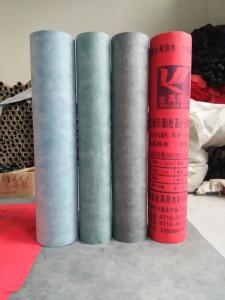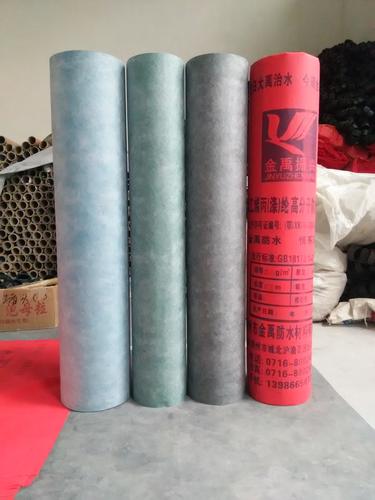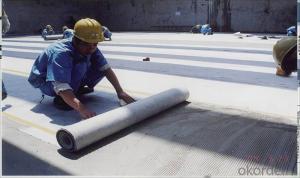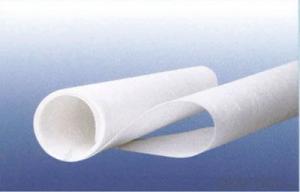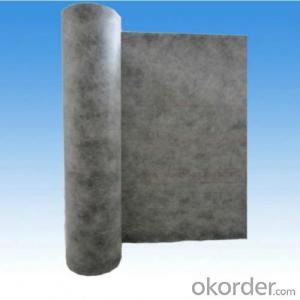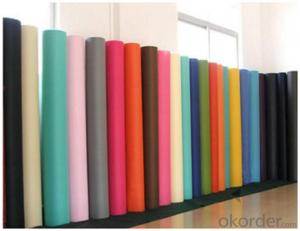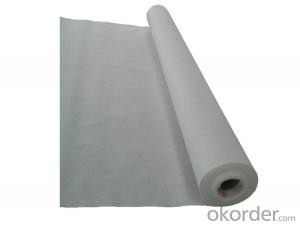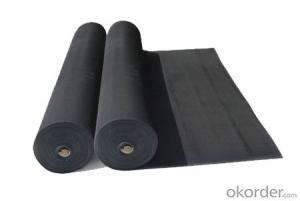High-polymer Polyethylene Polypropylene Waterproof Membranes
OKorder Service Pledge
OKorder Financial Service
You Might Also Like
Advantages:
The membrane is showed good performance on waterproofness
It will be a high-strength membrane to resist water
Puncture-resisting, tear-resisting, corrosion-resisting, mold-resisting and weather-resisting
Good tensile strength and elongation
Strong adaptability for substrate shrinkage, deformation and cracks
Both high and low-temperature resistance, especially in cold areas
Convenient to apply: use heat fusion method in all seasons
Usage: roof and underground in industrial and civil buildings, bridge, subway, tunnel, swimming pool
Our service:
Provide high-quality and competitive price
Professional sales to answer all your questions about products
Strict quality control of production
Timely communication during the production process
Provide technical support after sales if you needed
- Q: Can a waterproofing membrane be used for a shower pan?
- Yes, a waterproofing membrane can be used for a shower pan. It helps to prevent water leakage and protect the underlying structure from moisture damage.
- Q: Can a waterproofing membrane be recycled or disposed of in an environmentally friendly manner?
- Indeed, a waterproofing membrane has the potential to be recycled or disposed of in an environmentally conscious manner. Numerous waterproofing membranes are crafted from recyclable materials like polyethylene or polypropylene, which can be repurposed into new products. The act of recycling these membranes not only diminishes waste, but it also conserves resources and lessens the environmental impact associated with manufacturing fresh materials. In order to recycle a waterproofing membrane, it is crucial to consult local recycling facilities or waste management centers to determine if they accept this specific type of material. Some facilities might have specific guidelines or procedures for recycling membranes, thus adhering to their instructions is of utmost importance. In instances where recycling is not feasible, it is still possible to dispose of the waterproofing membrane in an environmentally friendly manner. Numerous waste management facilities allocate designated areas for construction and demolition waste, providing a proper means of disposing the membrane. These facilities employ methods that minimize the environmental impact of the waste, such as containment and controlled disposal techniques. It is of utmost importance to refrain from tossing the membrane in regular trash or illegally dumping it, as this could harm the environment and contribute to pollution. Proper disposal ensures that any potential pollutants or contaminants within the membrane are appropriately managed, thereby preventing harm to ecosystems and human health. In conclusion, by actively engaging in the recycling or environmentally friendly disposal of a waterproofing membrane, we can contribute to a future that is more sustainable and cleaner.
- Q: Are waterproofing membranes resistant to punctures?
- Yes, waterproofing membranes are designed to be resistant to punctures. They are typically made from durable materials that can withstand external forces without tearing or puncturing, ensuring long-lasting protection against water intrusion.
- Q: Are waterproofing membranes resistant to impact damage?
- Waterproofing membranes offer protection against water infiltration and typically resist impact damage to varying degrees. The level of impact resistance depends on the specific membrane type and quality. Generally, high-quality waterproofing membranes are designed to endure normal impacts and stresses that occur during installation and use. They are manufactured using durable materials, like modified bitumen, rubberized asphalt, or synthetic polymers, which enhance their strength and resilience. Although waterproofing membranes can withstand minor impact damage, they are not completely impervious to more significant impacts. Dropping heavy objects or sharp objects falling onto the membrane can potentially cause punctures or tears, compromising the integrity of the waterproofing system. This can result in water infiltration and potential structural issues. To enhance impact resistance, additional protective measures can be taken, such as installing a protective layer or using reinforced membranes. These extra layers or reinforcements provide an additional barrier against impact damage, ensuring the long-term performance and durability of the waterproofing system. In conclusion, while waterproofing membranes generally resist impact damage, it is crucial to handle them with care during installation and avoid unnecessary impacts that could potentially compromise their integrity.
- Q: Can a waterproofing membrane be used on below-grade foundations?
- Indeed, below-grade foundations can benefit from the application of a waterproofing membrane. It is highly advisable to utilize this method in order to avert water penetration and safeguard the foundation against moisture-related harm. By acting as a barrier, the membrane effectively obstructs the infiltration of water into the foundation walls, thus preventing complications like leaks, mold growth, and structural deterioration. Moreover, waterproofing membranes are specifically designed to endure the elevated water pressure commonly encountered in below-grade surroundings, rendering them an optimal choice for shielding foundations in basements and other below-ground edifices.
- Q: Can a waterproofing membrane be used in conjunction with sustainable construction materials?
- Indeed, the use of a waterproofing membrane alongside sustainable construction materials is gaining traction in the construction industry. This is due to the growing emphasis on environmentally friendly and energy-efficient buildings. Waterproofing membranes serve to safeguard sustainable construction materials, such as recycled or low-impact materials, against water damage and moisture infiltration. By forming a barrier, these membranes prevent water from permeating the materials, thereby extending their lifespan and reducing the necessity for repairs or replacements. Furthermore, sustainable construction materials are often engineered to enhance energy efficiency, which can be further augmented through the employment of a waterproofing membrane. By averting water damage, the membrane upholds the structural integrity of the building envelope, curbing potential energy loss from leaks or moisture intrusion. In addition, specific waterproofing membranes are designed with sustainability in mind. For instance, there are eco-friendly membranes fabricated from recycled materials or those that can be recycled at the end of their life cycle. These sustainable membranes minimize the environmental impact associated with their production and disposal. In conclusion, the integration of a waterproofing membrane in conjunction with sustainable construction materials is a wise and conscientious approach to building design. It ensures the long-term durability and performance of the materials, while also contributing to a more sustainable and energy-efficient built environment.
- Q: Can a waterproofing membrane be used on brick walls?
- Yes, a waterproofing membrane can be used on brick walls. It helps to prevent water penetration and protects the bricks from moisture damage.
- Q: Are waterproofing membranes suitable for indoor applications?
- Yes, waterproofing membranes are suitable for indoor applications. They are commonly used in areas such as bathrooms, basements, and kitchens to prevent water damage and moisture penetration. Waterproofing membranes provide an effective barrier against water and can help protect the structural integrity of buildings in indoor environments.
- Q: Can a waterproofing membrane be used on tunnels with emergency exits?
- Yes, a waterproofing membrane can be used on tunnels with emergency exits. In fact, it is highly recommended to use a waterproofing membrane in such tunnels to prevent water infiltration and protect the structural integrity of the exits. Waterproofing membranes are designed to create a barrier against water and moisture, ensuring that the tunnels remain dry and free from water damage. This is especially important for emergency exits, as they need to be accessible and functional at all times. By installing a waterproofing membrane, the tunnels can be effectively protected from potential water ingress, ensuring the safety and usability of the emergency exits.
- Q: Can a waterproofing membrane be used in conjunction with tile or stone installations?
- Yes, a waterproofing membrane can definitely be used in conjunction with tile or stone installations. In fact, it is highly recommended to use a waterproofing membrane in wet areas such as bathrooms, showers, and kitchen backsplashes to prevent water damage and moisture penetration. A waterproofing membrane acts as a barrier that prevents water from seeping through the tile or stone and reaching the underlying layers, such as the subfloor or wall. It helps to protect the structure and prolong the lifespan of the installation. There are various types of waterproofing membranes available, including liquid-applied membranes, sheet membranes, and fabric membranes. These membranes can be applied to the substrate before the tile or stone is installed, creating a waterproof layer that ensures the area remains dry and free from water-related issues. Using a waterproofing membrane not only provides protection against water damage but also helps to prevent the growth of mold and mildew, which can be harmful to both the installation and the health of the occupants. It is important to note that the proper installation of the waterproofing membrane is crucial for its effectiveness. It should be applied according to manufacturer guidelines and best practices to ensure a tight seal and complete coverage. Overall, incorporating a waterproofing membrane with tile or stone installations is a wise choice, as it enhances the durability and longevity of the project while providing peace of mind against potential water damage.
Send your message to us
High-polymer Polyethylene Polypropylene Waterproof Membranes
OKorder Service Pledge
OKorder Financial Service
Similar products
Hot products
Hot Searches
Related keywords
